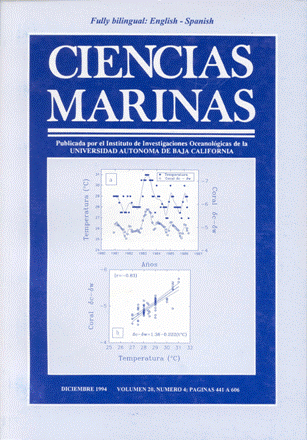Ecological factors that determine distribution and abundance of the California sea lion Zalophus Californianus in the Gulf Of California
Main Article Content
Abstract
The population of the California sea lion Zulophus californianus (Lesson, 1828) in the Gulf of California during the breeding seasons of the 1980’s was estimated at 23,256 individuals, and 31,393 if census adjustments are applied. Of this total (23,256), 6.9% were adult males, 5.0% subadult males, 40.7% adult females, 23.9% juveniles, 22.7% pups (less than one year of age) and 0.8% were termed miscellaneous. Eighty-six percent of the 29 sea-lion colonies studied were on islands, while the remaining colonies occupied capes of the mainland. However, around 98.8% of the sea-lion population was counted on islands. The number of islands (available habitat) did not determine the sea-lion distribution in the gulf, but the concentration of its usual preys (sardine, anchovy, mackerel and hake) did. Eighty-two percent of the sea-lion population and its pup production took place in the northern region of the Gulf of California (from Isla San Esteban northward), which seems to be associated with the major abundance of small pelagic fish in the gulf. California sea lions tend to inhabit small- and medium-sized islands (less than 3 km in length), which amount for 80% of the sea-lion population. The probable factors that determine the selection of islands this size are: 1) the absence of terrestrial predators, 2) easier communication of breeding animals and 3) sexual selection advantage for mating individuals. The operational sex ratio varied according to island size in a negative exponential trend. More adult females were available per adult males on smaller islands, since reduced space clumped the females. This clumping effect enhances a higher male-male competition (with an evident advantage for males), but also a higher quality of territorial males for the breeding females.
Downloads
Article Details
This is an open access article distributed under a Creative Commons Attribution 4.0 License, which allows you to share and adapt the work, as long as you give appropriate credit to the original author(s) and the source, provide a link to the Creative Commons license, and indicate if changes were made. Figures, tables and other elements in the article are included in the article’s CC BY 4.0 license, unless otherwise indicated. The journal title is protected by copyrights and not subject to this license. Full license deed can be viewed here.

